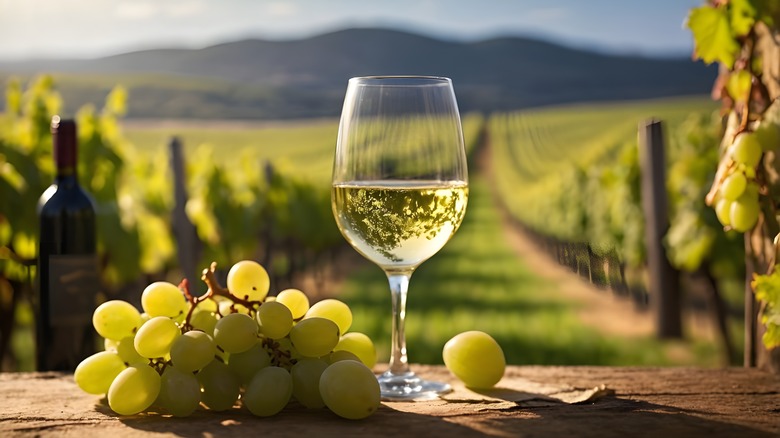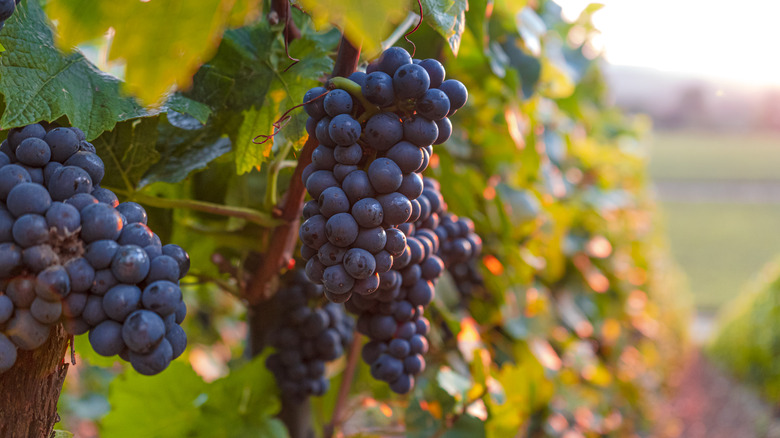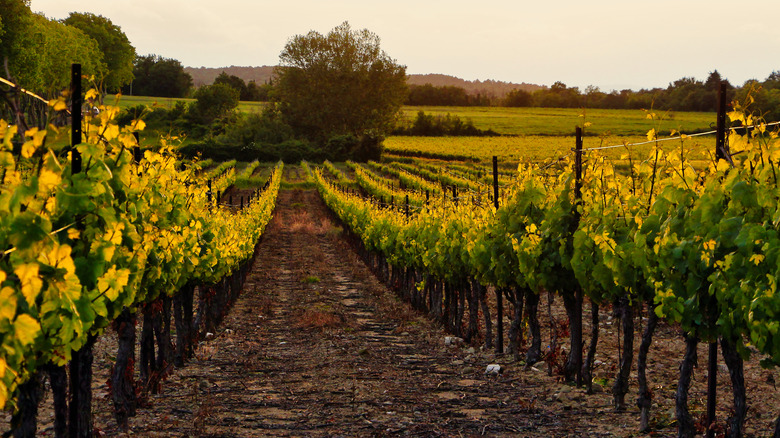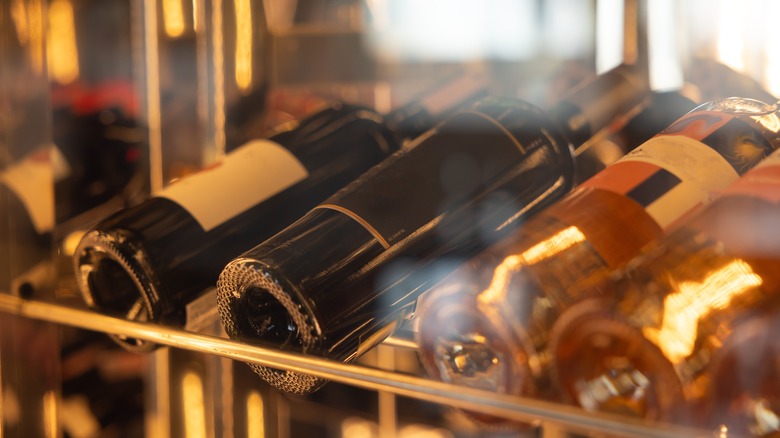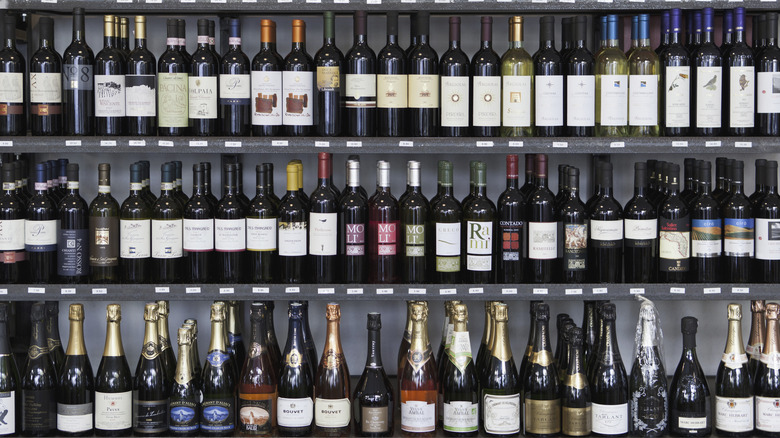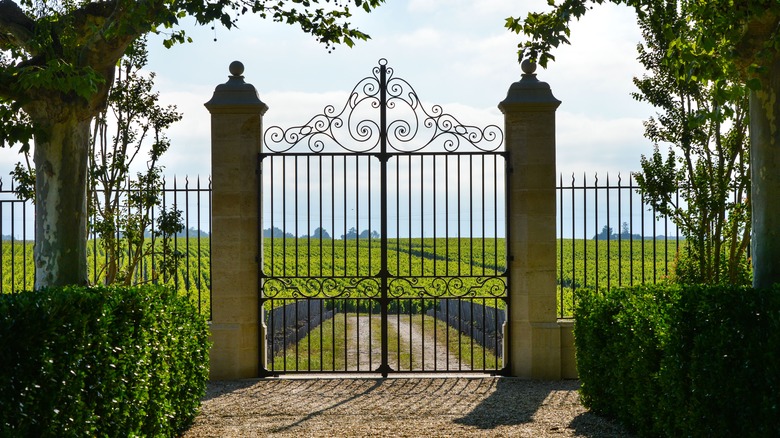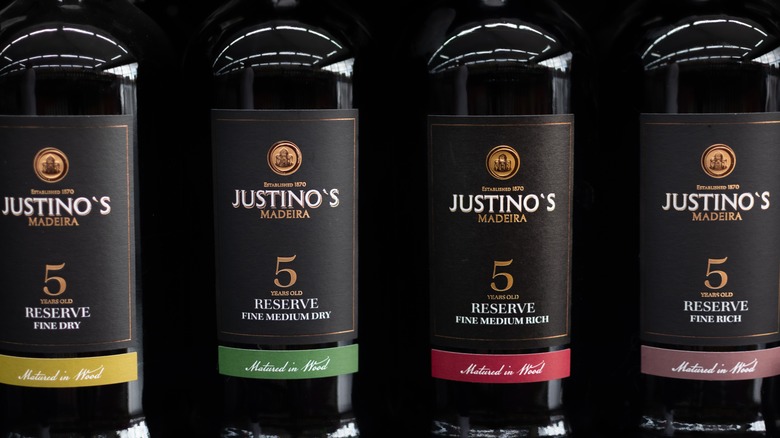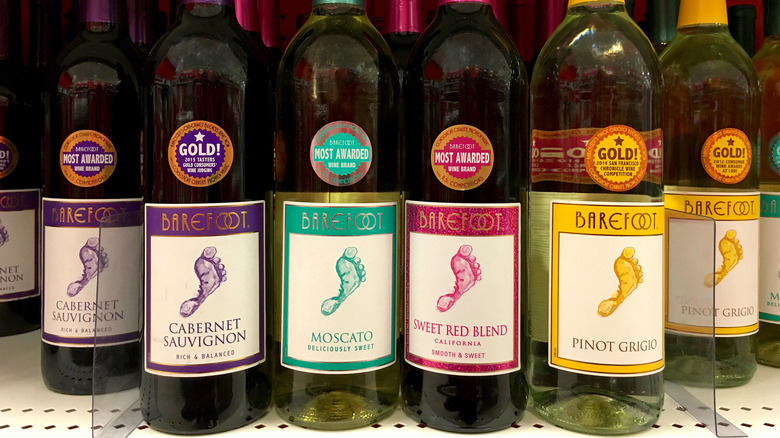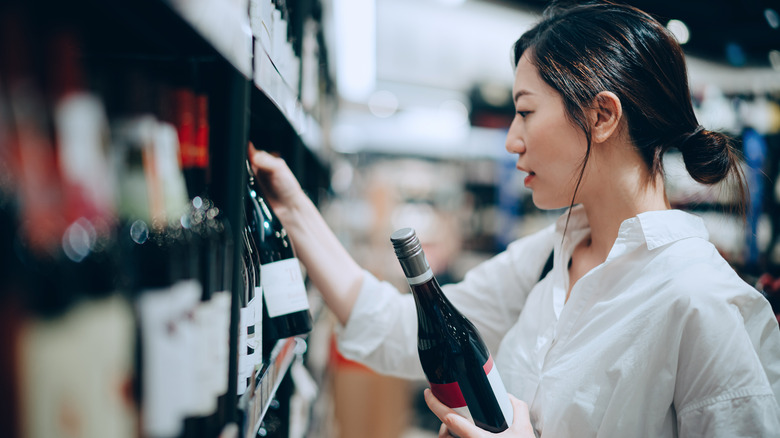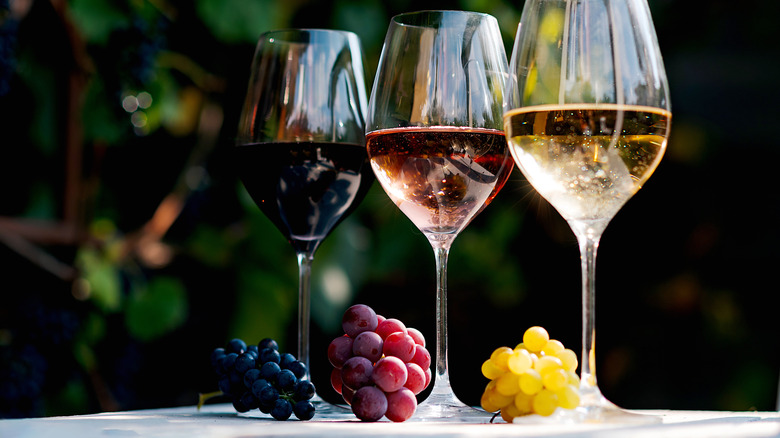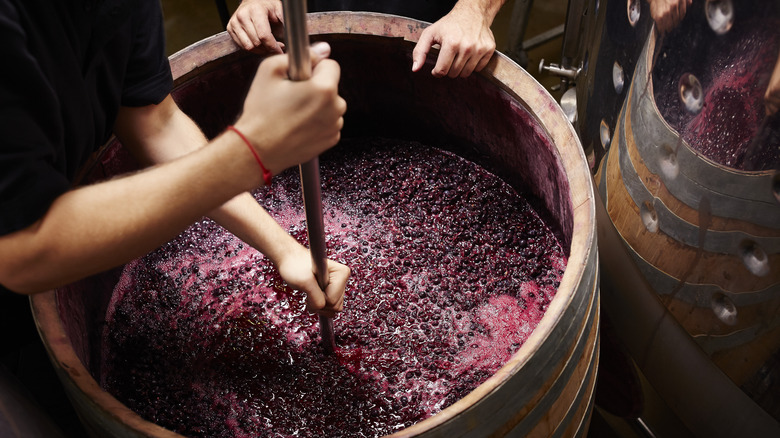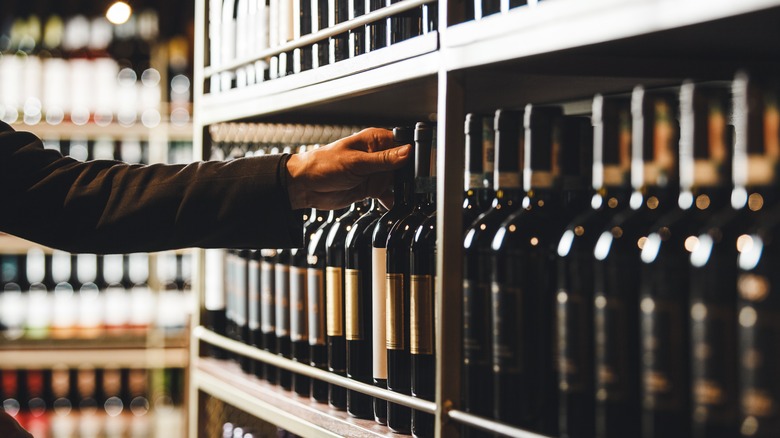Everything You Need To Know About Reading Wine Labels
For many casual wine drinkers, reading wine labels can feel overwhelming. With the amount of information on them, it can be hard to know what to focus on. Fortunately, simplifying the process is possible. Master Sommelier Lennon Wiser says that if you're picking out a random bottle of wine at the store, "prioritize choosing a wine by varietal, then appellation, then vintage, and finally producer." In layman's terms, this means you start by choosing a grape, then a region, then the year, and then the brand — in that order. For example, if you know you like the pinot noir grape, start there, and then narrow it down by the other factors.
That being said, other key elements on the label can help guide your decision as well — or be safely ignored. Terms like "Estate Bottled" or "Single Vineyard" provide valuable insight into where the grapes were grown and how the wine was produced. However, a flashy term like "Reserve" may not mean as much as you think it does. In this guide, with the help of Wiser, we break down all aspects of a wine label to help you decode the bottle with confidence so you can make informed choices without feeling overwhelmed by the fine print.
Grape varietal is key
According to Lennon Wiser, grape varietal is "the most important factor when choosing a wine." The grape varietal is the core of the wine's flavor profile and character. Everything else comes after, shaping how that type of grape expresses itself. "A consumer should definitely know the basics of the major grape varieties before buying," Wiser advises. Otherwise, it's a complete shot in the dark. If you're fairly unfamiliar with the difference between grapes, Wiser "strongly recommends starting at a good wine shop and asking for help."
Understanding grape varieties not only enhances your ability to select wines you enjoy but also helps you discover new favorites. For instance, if you enjoy the bold flavors of cabernet sauvignon, you might also begin to appreciate other varietals known for their rich, full-bodied characteristics, such as syrah or malbec. By recognizing the key attributes of the grapes you like, you can more easily identify and enjoy wines that offer comparable experiences, broadening your palate and enhancing your wine selection journey. Fortunately, the varietal is almost always clearly listed on every label, making it straightforward to identify the main type of grape used in the wine.
Don't overlook grape varietal proportions
Most varietal wines are, in fact, blends — something that Lennon Wise says the vast majority of people don't realize. In other words, even bottles that don't label themselves as a blend typically have some quantity of other varietals mixed in. According to U.S. law, if a bottle contains 75% or more of a certain grape varietal, the other varietals don't have to be listed. Still, more and more brands have started to include wine varietal proportions on the label, so it is something to be aware of — especially if you're a true wine connoisseur. "It does give a little more insight into the wine and its potential characteristics," Wiser explains.
The thing is, this detail is less crucial for most wine lovers. The subtle differences in taste from these proportions are often imperceptible to the casual drinker. "It is more important to find a wine that you like than worrying about single varietal versus blend," Wiser says. Personal taste is the best guide in selecting a wine, regardless of the exact proportions of each varietal.
Appellation is important to consider
Another key detail on a wine label is the appellation, or the region where the grapes were grown. Lennon Wiser emphasizes that the appellation is "the second-most important factor in choosing wine, only second to the grape varietal itself." The region produces a variety of factors, some of which the average wine drinker probably wouldn't ever consider. "You have volcanic soils versus sedimentary soils, limestone deposits, vine depth, fog cover, and how much sun the vineyards receive when they need it. These will all make the wines completely different," he explains.
For example, "a pinot noir from the Red Hills of Oregon is going to taste vastly different than one from Burgundy or the Russian River Valley in California," Wiser adds. Each region gives its own unique twist to the wine, so knowing where a wine comes from can really guide you in choosing something that fits your taste. This is all the more reason to keep an eye on the appellation — it's a great way to find wines that match your preferences and discover new favorites.
Vintage can be tricky
The vintage of a wine — the year the grapes were harvested — can have a big impact on its flavor and quality. This is because each vintage reflects the growing conditions of that specific year, like temperature, rainfall, and sunlight. These factors affect grape ripeness, sugar levels, and acidity, all of which influence the wine's taste. This is why noting the vintage on the label can be helpful when choosing a wine.
Lennon Wiser explains, "If a winemaker specifically makes a wine with the intent of aging it, such as a huge Estate Cabernet or a Premier Cru Burgundy, then it absolutely should be aged to allow the wine to reach its full potential." However, he also points out that winemakers are focusing more on producing wines that should be consumed earlier — within 3 to 5 years after their release.
That means you'll usually get the best flavor in bottles that are around 3 to 5 years old. If you're picking up a bottle on a quick shopping trip, Wiser has a little tip: "Look towards the back of the shelf. You'll often get lucky and find the same bottle with a slightly older vintage." A year or two of extra aging can really enhance the wine's immediate drinking experience.
Brand is a fine place to start
When it comes to selecting a bottle of wine, many people assume the brand name is the most important factor. The truth is another story. Yes, a well-known producer can offer some assurance of quality and flavor, as they often have consistent practices. "Choosing a solid brand name from a reputable producer is not a bad place to start," Lennon Wiser explains, especially if you're unsure about the other details on a label. But a brand name is "not quite as important as people may think, once someone becomes familiar with the types of wine they like to drink," adds Wiser.
Instead, other elements, such as varietal, region, and vintage, will usually guide you toward a better selection, because they directly influence the wine's flavor, body, and complexity. Taking the time to get to know your personal taste preferences and the specific characteristics of different varietals, regions, and vintages makes these factors much more reliable indicators of quality than just a brand name alone.
Enthusiasts search for vineyard
On a wine label, the term "vineyard" indicates the exact location where the grapes were grown, which is different from "appellation," which refers to a broader region. Essentially, a vineyard is like an address for the grapes. This detail can offer valuable insights into the wine's quality and character. However, it isn't always listed because sometimes grapes are sourced from multiple vineyards, or the producer may choose not to highlight specific locations.
"There are world-class vineyards out there that have years of pedigree and history," Lennon Wiser says. "When a winemaker or winery gets to source fruit from these types of vineyards, they will certainly add this to the label." They highlight it to showcase the prestigious source of the grapes and attract experienced wine enthusiasts who value the unique characteristics that come from these renowned locations. So, as you get more experienced in wine, when a vineyard is listed on the label, it can be a helpful clue toward the wine's quality.
Special designations might not be so special
When you see terms like "Reserve" or "Special Selection" on a wine label, don't be fooled into thinking they guarantee a top-notch bottle. Lennon Wiser makes it clear that these designations are not usually indicators of quality. "Honestly, they generally mean absolutely nothing," he explains. "This is just a marketing tactic." In regions like California, wineries can use these labels without adhering to any strict guidelines about what's actually in the bottle or how long it was aged.
There are exceptions to this, though. For example, in certain European regions, like Chianti, Italy, the term "Reserva" does have a specific meaning — it indicates that the wine has been aged longer than a standard Chianti Classico. But these exceptions are relatively rare, and most designations don't significantly impact the wine's overall character.
So, instead of relying on these designations for a measure of quality, it's a better idea to consider more important factors like the grape varietal, vintage, and region of origin when selecting a bottle. This approach will give you a more accurate picture of what to expect from the wine.
Certifications are more marketing-focused
Certifications like "organic" or "sustainably produced" on a wine label might sound reassuring, but Lennon Wiser sees them differently. And when a master sommelier expresses skepticism, it's worth paying attention. "I believe winemakers and wine marketing companies that use 'organic,' or 'sustainably produced,' on the bottle are doing this to help market the wine," he explains.
"Vineyard managers and winemakers all around the world take great pride in managing their grapes with the utmost care," notes Wiser. The majority of wineries and vineyards globally are "growing and producing sustainably produced, high-quality wine." On top of that, it's worth remembering that the term "organic" on a label doesn't always mean the wine is entirely organic — it could only refer to certain parts of the production process. So, while organic or sustainable claims call attention to the wine, focusing too much on these certifications can lead to disappointment.
Awards are, too
Seeing an award on a wine label might seem like a reliable sign of quality, but Lennon Wiser advises otherwise. "Usually, this is a marketing gimmick to help sell an underwhelming wine," Wiser explains. In other words, the accolades are meant to catch your eye so you're drawn to the bottle, but they often have little to do with the actual quality of what's inside.
"I'm not a fan of any marketing on the bottle," Wiser continues. "Less is more when it comes to the label and the quality of the wine." In his view, the more a bottle relies on flashy labels or accolades, the less likely it is to live up to the hype. Instead of being swayed by awards or certifications, Wiser recommends focusing on more meaningful aspects when selecting a wine. Paying attention to the grape varietal, the region it's from, and the vintage will give you a better understanding of the wine's true character and quality.
The simpler the label design, (usually) the better
Many people use a wine label design to help them decide which bottle to choose, but Lennon Wiser advises against this approach. "The unassuming bottle without all the flashy artwork is almost always the better choice," he says. According to Wiser, wines with bold, over-the-top designs may be trying to compensate for a lack of quality. While there are always exceptions, in most cases, these eye-catching bottles rarely deliver on the promise of their packaging.
Instead of relying on beautiful labels, Wiser encourages focusing on the wine itself. Bottles with simpler labels often come from producers who prioritize quality over marketing gimmicks. He explains that wineries investing heavily in eye-catching designs may be diverting money that could have been spent on better ingredients and production methods. In other words, you might be paying more for the label than the actual wine. Wiser's advice suggests that the understated labels often indicate that more attention has been paid to what's inside the bottle rather than what's wrapped around it.
Tasting notes and pairing suggestions
Tasting notes and pairing suggestions sometimes appear on wine labels, but their reliability can be hit or miss. Lennon Wiser acknowledges that tasting notes can be helpful, saying, "It's always helpful to get someone's interpretation of the wine." Publications like Wine Spectator and Wine Enthusiast are known for insightful tasting notes, often provided by experienced tasters who can accurately describe a wine's flavor profile. However, when it comes to the notes printed directly on a bottle, the source of these descriptions can be unclear. They might be crafted by experts, but they could also come from a marketing team.
Regarding food pairing suggestions, Wiser notes, "Most great wines never print this on the bottle." If you're browsing wines and want some extra information on the spot, the internet is a safer bet. "It is better to look up the wine itself online and see what others have said about it," he says. For the most accurate advice, consulting reviews and ratings from reputable sources can provide a more dependable guide than the notes on the label.
European labels versus American labels
Wine labels in the U.S. and Europe are structured a bit differently, and understanding these differences can be helpful when selecting a bottle. "Usually in the U.S., everything is listed — the name, varietal, region, appellation, and vineyard," Wiser says. "They often even note the specific blend."
In Europe, however, the label may focus more on the region rather than explicitly listing the varietal. "In places like France and Italy, the appellation, or town itself, dictates the varietal," Wiser notes. For example, an Italian wine that lists the appellation Brunello di Montalcino is always made from sangiovese grapes grown in that area, so there's no need to list the varietal — it's assumed. The same goes for the appellation Côte-Rôtie in France, which is always a syrah. These are just two examples, though there are many others.
Because of this, navigating certain European wine labels may require some research. Luckily, if you find a European wine without the varietal listed, you can always pull out your phone and look it up.
Alcohol and sulfite content aren't huge factors
If you ask Lennon Wiser, the alcohol content listed on a wine label isn't something you need to put much thought into. For one, it doesn't have a huge impact on the wine's overall taste. "The difference between a 12.5% ABV Riesling and a 14% ABV Cabernet is pretty minimal," he says. Alcohol level is simply a byproduct of the fermentation process — grapes with more sugar naturally produce more alcohol. Red grapes, which are often harvested later than white grapes, typically contain more juice, leading to a higher alcohol by volume (ABV). While alcohol levels do influence the wine's structure, a skilled winemaker can balance the flavors through blending and aging techniques.
Sulfites, by law, must be listed on all wine labels in most parts of the world, but Wiser emphasizes that they're a natural part of wine. "To be clear, all wine contains sulfites, unless removed through special processes," he explains. Though sulfites sometimes get a bad reputation, there's no great way to avoid them if you want to drink wine. For anyone who is allergic, there are wines where the sulfites have been chemically removed, but Wiser doesn't recommend choosing them unless you have no other choice, as these wines tend to lose some of their natural qualities in the process.
Price isn't always everything
While not directly related to the label, understanding wine pricing can be incredibly useful for casual wine shoppers. Lennon Wiser points out that the difference in quality between a $10 and a $25 bottle is often more noticeable than between a $25 and $50 or even $100 bottle. For those still refining their taste, the $20-$25 range generally offers a great balance of quality and value. In this price range, you're more likely to get a higher quality, thoughtfully-crafted wine.
Wiser warns against settling for wine below roughly $20 because, below that price point, a good bottle is few and far between. "If you find them, they're usually from a local winery," Wiser explains. "But if you're getting it at a grocery store, no chance." When you get down to $10 and below, he says the wines commonly suffer from quality issues, because that cost is mostly covering production, shipping, and taxes (if imported). This doesn't leave much left for the wine itself. So, spending just a little a bit more ensures you're getting a wine that delivers on both taste and quality, making it worth the investment.

